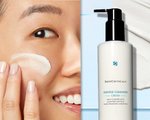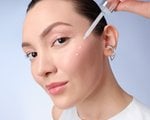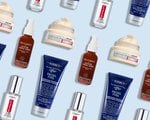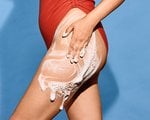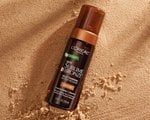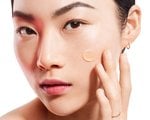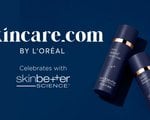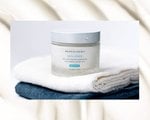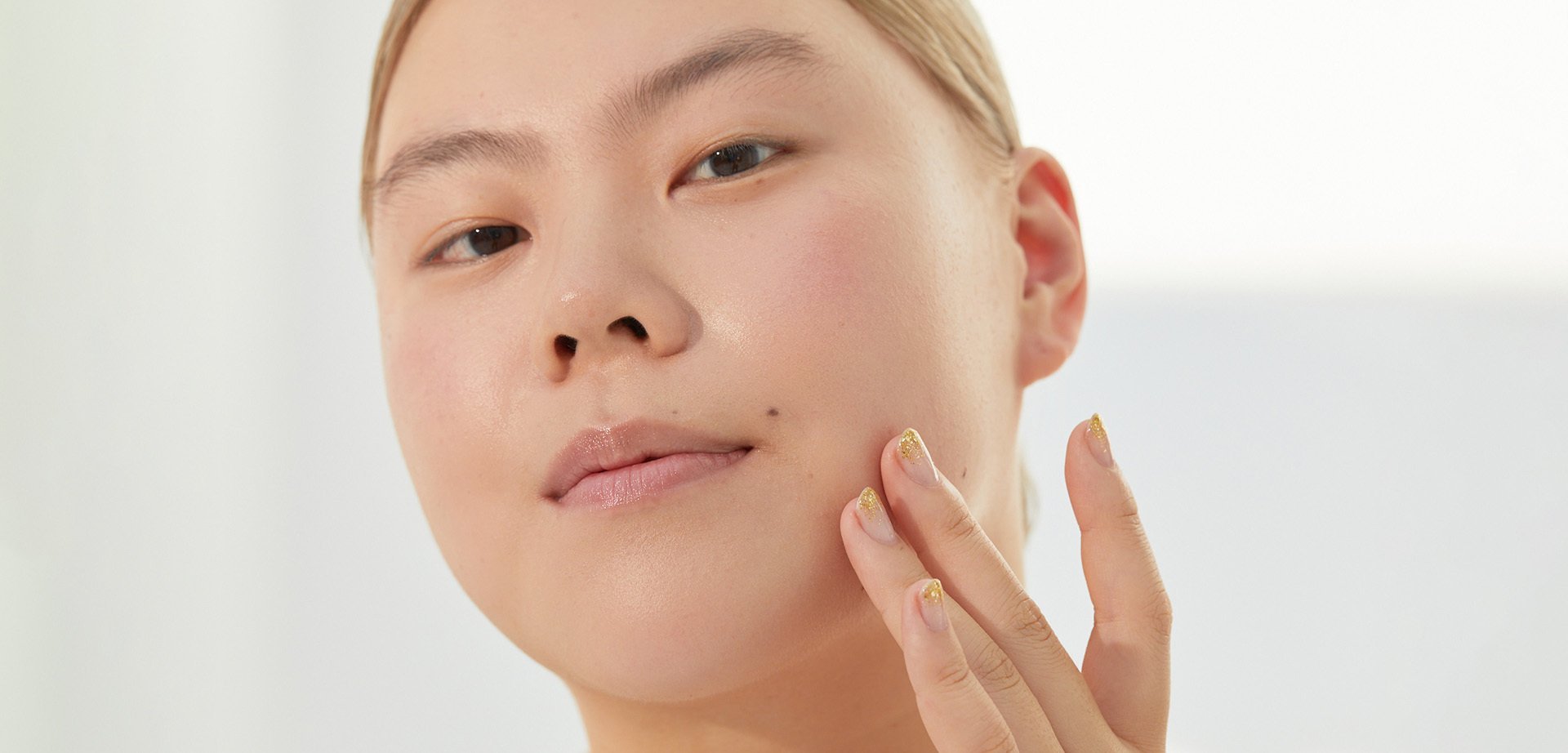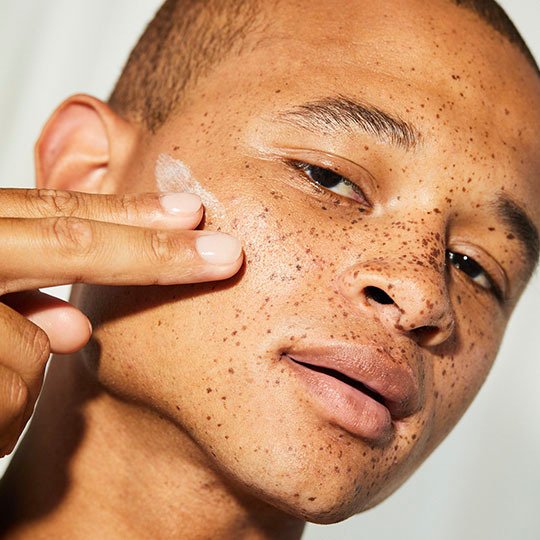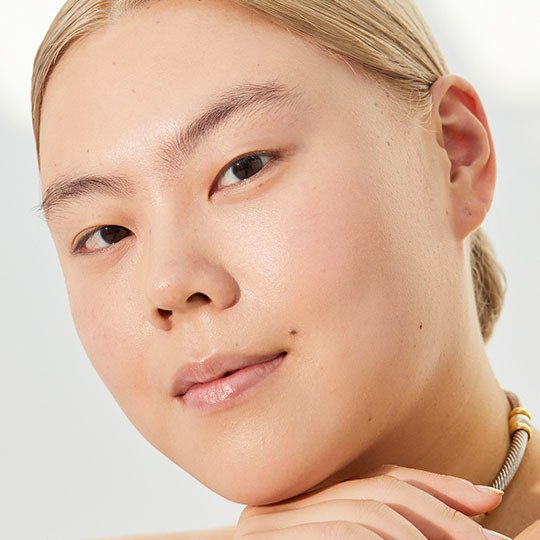How to Address Dark Spots
October 28, 2024
What Are Dark Spots?
Dark spots are a form of hyperpigmentation. According to the Cleveland Clinic, they develop when your skin produces too much melanin (the pigment that gives your skin its color). They can vary in size and usually appear gray, pink, or brown in color, depending on your skin tone and where the discoloration is. They can occur anywhere but are most common in areas frequently exposed to the sun, including the face, chest, and shoulders, per the Mayo Clinic.
What Causes Dark Spots?
Before we discuss what fades dark spots—or at least helps minimize their appearance—we thought it’d be helpful to review what causes them to develop in the first place. Here are some of the biggest culprits to be aware of:
- Sun exposure: According to board-certified dermatologist Dr. Heather Woolery-Lloyd, MD, FAAD, dark spots can develop “after years of exposure to the sun.” These dark spots are known as solar lentigines or sun spots and they generally develop later in life.
- Acne: Per Dr. Woolery-Lloyd, “acne is a common cause of dark spots.” After a breakout heals, a stubborn brown or pinkish patch may develop where the pimple originally was. These dark spots are also known as post-inflammatory hyperpigmentation or post-acne marks and are more likely to develop if you pick at or pop your pimples (so hands off).
- Injuries: Discoloration or darkening of the skin can develop in response to a minor skin injury, such as a burn or an insect bite, says Dr. Woolery-Lloyd.
- Hormones: According to the American Academy of Dermatologists (AAD), hormonal fluctuations may lead to dark spots and discolorations. If you have a new dark spot or patches of discolored skin on your face or chest and can’t figure out the underlying cause, it may be worth scheduling a visit with your dermatologist.
Can Dark Spots Go Away?
While dark spots may fade on their own over time, this process can take quite a while (and they may not disappear completely). Some skincare products, however, can help fade their appearance. If you’ve been following a consistent skincare routine for dark spots and aren’t seeing significant improvement, consider scheduling a visit with your dermatologist. They may have access to products or treatments that can effectively remove dark spots and help prevent new discoloration from appearing.

What Ingredients Help With Dark Spots?
As mentioned, adopting a consistent, targeted skincare routine is one of the best things that you can do to help reduce dark spots. But, it’s important to use the right products. Luckily, there are several ingredients that may help to improve the appearance of dark spots and discolorations. These include:
- Sunscreen: Sunscreen is extremely important for managing dark spots, Dr. Woolery-Lloyd notes. “[SPF] is just as important as topical treatments. Without daily sunscreen, it is much harder to improve dark spots. Sunscreen is also very important for preventing dark spots.” Follow the United States Food and Drug Administration (FDA) guidelines and opt for a broad-spectrum sunscreen with an SPF of at least 15—and be sure to reapply it at least every two hours.
- Vitamin C: Skincare products with vitamin C can help brighten the skin and may reduce the appearance of dark spots, says Dr. Nancy Ilaya, the scientific director at Kiehl’s.
- Retinol: Products with retinol can help improve several signs of skin aging, including fine lines, wrinkles, and discoloration. If you’re interested in adding retinol to your routine, it may be worth looking for a product specifically intended for managing dark spots. “The overall formula is more important than a specific percentage when it comes to treating hyperpigmentation with retinol,” explains Dr. Woolery-Lloyd.
- Niacinamide: Skincare products with niacinamide—also known as vitamin B3—may help brighten the skin and improve the appearance of discolorations to promote a clearer, more uniform complexion.
- Alpha-hydroxy acids (AHAs): In some cases, using an exfoliating ingredient like AHAs can help slough off dead cells on the skin’s surface to reveal brighter, clearer, more even-looking skin.
- Melasyl: “Melasyl is the newest ingredient to treat dark spots,” says Dr. Woolery-Lloyd. This patented ingredient is featured in the La Roche-Posay Mela B3 Dark Spot Serum With Melasyl + Niacinamide, which helps visibly address a range of skin discolorations to reveal brighter, more radiant-looking skin over time.
- Licorice root extract: This gentle ingredient is considered a natural skin brightener, which is why it’s found in many products that help fade dark spots on skin.
How To Help Reduce the Appearance of Dark Spots
If you’re hoping to get rid of dark spots on your skin, you may want to start by adjusting your expectations. While dark spots typically fade with time, there’s no 100% guaranteed way to eliminate discolorations entirely. With that being said, there are things that you can do to help fade their appearance. Here are six tips to follow for more even, uniform skin.

Tip 1: Wear broad-spectrum sunscreen every day
According to board-certified dermatologist and Skincare.com consultant Dr. Dendy Engleman, sunscreen is one of the best defenses against dark spots. “If you’re not giving your skin daily protection, the pigment is going to stay,” she says. Sun exposure doesn’t only cause dark spots—it can make existing discolorations more prominent, per the AAD.
And you can’t just count on the SPF in your moisturizer or foundation to be enough. Dr. Engelman says that the reality is that you’d need to put on quite a bit more product than you’d normally use in order to get an adequate amount of sun protection. As such, you’ll want to make sunscreen a part of your everyday skincare routine (no exceptions). For the best results, use a broad-spectrum formula with an SPF of at least 15 and apply it at least every two hours, or after sweating, swimming, or toweling off.
Try the La Roche-Posay Anthelios UV Hydra Hydrating Face Sunscreen SPF 50 with Hyaluronic Acid. The hydrating formula has a barely-there texture and blends evenly on all skin tones, leaving behind a dewy, healthy-looking finish. If you’d prefer a tinted sunscreen, try the La Roche-Posay Anthelois Mineral Tinted Sunscreen for Face with SPF. The 100% mineral formula comes in four flexible shades and provides broad-spectrum SPF 50 protection against UVA and UVB rays. You can wear it alone or layer it under foundation—the non-greasy formula provides a smooth, even base for your makeup application.
Along with sunscreen, it’s a good idea to limit your time in the sun (especially during peak sun hours between 10 a.m. and 2 p.m.) and wear protective clothing—like wide-brimmed hats and long-sleeved shirts— to help shield your skin from UV rays.

Tip 2: Never pick pimples
As we mentioned earlier, dark spots often develop after a breakout, though the risk is often higher if you pick at, scratch, or pop a blemish. If you notice a pimple brewing, don’t touch it. Instead, apply a targeted spot treatment to help target the blemish.
We love the Kiehl's Truly Targeted Acne-Clearing Pimple Patch with Salicylic Acid. It’s made with salicylic acid, niacinamide, and licorice root extract and helps reduce pimple size and color while visibly minimizing the appearance of post-blemish marks over time. To use it, gently dab a drop of the liquid formula onto clean, dry skin over the blemish or problem area. Once the formula dries, you can layer your normal products—sunscreen, foundation, and even concealer—on top.

Tip 3: Use a dark spot treatment
If you’re reading this, you’re likely hoping to learn how to eliminate dark spots. Unfortunately, it’s not that simple—dark spots can take months or even years to fade once they develop, per the AAD. Adding dark spot treatments to your skincare routine, however, may help speed along the process.
The Kiehl’s Auto-Tone Discoloration & UV Serum is one of our favorite products in this category. It’s made with 0.5% Melasyl and is uniquely designed to help visibly fade dark spots, post-blemish marks, dark patches, and uneven skin tone. Plus, it contains broad-spectrum SPF 30 sunscreen in its formula to help protect your skin from the sun. You can use it as the last step in your morning skincare routine—just be sure to allow it a few moments to absorb before applying makeup. At night, try a dark spot serum, such as the Kiehl’s Clearly Corrective Dark Spot Serum, which helps diminish dark spots and improves the appearance of skin texture and tone.

Tip 4: Exfoliate with acids
While exfoliation alone is unlikely to erase dark spots, consistent gentle exfoliation can help to promote a brighter, more even-looking complexion.
There is no shortage of exfoliation products to choose from, but if dark spots are your primary concern, we suggest reaching for an at-home peel, such as the L’Oréal Paris Bright Reveal Dark Spot Exfoliant Peel. The professional-inspired formula contains alpha, beta, and polyhydroxy acids in its formula and helps visibly fade all types of dark spots with regular use. Unlike serums and dark spot treatments, this at-home peel isn’t intended for daily use. You can use the powerful formula up to four times per week (at night), though if you’re new to exfoliation or have sensitive skin, we suggest starting with once-weekly usage and gradually working your way up to every other night. You’ll also want to avoid using it on days that you use retinoids or other chemical exfoliants, including exfoliating toners or serums.

Tip 5: Reach for retinol
Products with retinol may help address a wide range of skin concerns, from fine lines and wrinkles to—you guessed it—dark spots and discolorations. However, if you’ve never used retinol before, it’s best to start slow. Retinol can leave the skin feeling dry, tight, or irritated, particularly if you’re using it for the first time or using a product with a high concentration of retinol.
If you’re interested in incorporating retinol into your routine, Dr. Engleman suggests starting with a gentle over-the-counter product, as they’re typically less aggressive than prescription retinoids. We’re big fans of the L'Oréal Paris RevitaLift Derm Intensives Night Serum with 0.3% Pure Retinol. It helps visibly reduce wrinkles, refines skin texture and tone, and leaves the skin looking brighter and more radiant with continued use. Start by using the serum once weekly as part of your regular nighttime skincare routine. As your skin adjusts, you can gradually increase the frequency up to nightly.
Tip 6: Visit your dermatologist
A proper skincare routine can go a long way in helping to improve the appearance of dark spots and discolorations. But if you have particularly stubborn dark spots—or are finding that over-the-counter products aren’t providing the results you want—it may be a good idea to speak with your dermatologist. They may be able to prescribe powerful creams or ointments or suggest skincare treatments (such as laser facials) to help fade dark spots on your skin more rapidly.
Next Up: What Is Retinol and What Are the Skincare Benefits?
Read more
EXPLORE BY TOPICS AND BRANDS
- skin-concerns
- Skin Discoloration
- expert-advice
- Ask the Expert
- video-embed
- Embedded Video
- CeraVe
- SkinCeuticals
- Youth To The People
